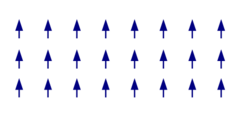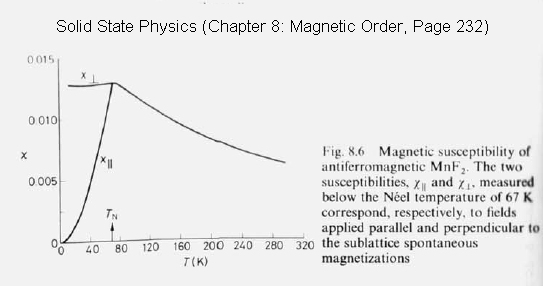Solution to Set 3: Difference between revisions
(Linking) |
|||
| Line 43: | Line 43: | ||
'''Use [[PHZ3400 Symmetry Breaking#Ferromagnet and Curie-Weiss Theory|Weiss mean-field decoupling]] to replace one of the spins in the Hamiltonian by its thermal average. The Weiss field experienced by a given spin is then proportional to the sublattice magnetization on the other sublattice. Write down self-consistent equations for <math>m_A\;</math> and <math>m_B\;</math>, and express them through the order parameters <math>m\;</math> and <math>m^{\dagger}</math>.''' | '''Use [[PHZ3400 Symmetry Breaking#Ferromagnet and Curie-Weiss Theory|Weiss mean-field decoupling]] to replace one of the spins in the Hamiltonian by its thermal average. The Weiss field experienced by a given spin is then proportional to the sublattice magnetization on the other sublattice. Write down self-consistent equations for <math>m_A\;</math> and <math>m_B\;</math>, and express them through the order parameters <math>m\;</math> and <math>m^{\dagger}</math>.''' | ||
Given the Hamiltonian for a classical [[Ising model|Ising antiferromagnet]] on a [[Bipartite lattice|”bipartite” lattice]]: | |||
<math> H = \frac{J}{2} \sum_{<ij>} S_i S_j -− h\sum_i S_i </math> | <math> H = \frac{J}{2} \sum_{<ij>} S_i S_j -− h\sum_i S_i </math> | ||
< | where | ||
* <math>H</math> = Hamiltonian, the total energy of the system | |||
* <math>J</math> = Interaction Energy where J < 0 because it’s anti-ferromagnetic | |||
* <math>S</math> = Spin with value of 1 or -1 | |||
* <math>h</math> = Magnetic field energy from external sources that breaks the symmetry | |||
The | The magnetization on each sublattice | ||
==Part 2== | ==Part 2== | ||
Revision as of 01:59, 2 March 2009
Ferromagnetism
| ||||||||
Given Information
- Classical Ising antiferromagnet on a ”bipartite” lattice given by Hamiltonian Failed to parse (syntax error): {\displaystyle H = \frac{J}{2} \sum_{<ij>} S_i S_j -− h\sum_i S_i } ,
- Magnetization for Lattice A:
- Magnetization for Lattice B:
- Average magnetization:
- "Staggered” magnetization:
(Note: It's the difference between the two sublattices)
- for perfect ferromagnetic order
- for perfect antiferromagnetic order
Part 1
Use Weiss mean-field decoupling to replace one of the spins in the Hamiltonian by its thermal average. The Weiss field experienced by a given spin is then proportional to the sublattice magnetization on the other sublattice. Write down self-consistent equations for and , and express them through the order parameters and .
Given the Hamiltonian for a classical Ising antiferromagnet on a ”bipartite” lattice:
Failed to parse (syntax error): {\displaystyle H = \frac{J}{2} \sum_{<ij>} S_i S_j -− h\sum_i S_i }
where
- = Hamiltonian, the total energy of the system
- = Interaction Energy where J < 0 because it’s anti-ferromagnetic
- = Spin with value of 1 or -1
- = Magnetic field energy from external sources that breaks the symmetry
The magnetization on each sublattice
Part 2
Assume that , so that , and solve the mean-field equations by expanding in . Determine the Neel (ordering) temperature, and calculate the order-parameter exponent.
The Néel Temperature
Chapter 8.4 of Solid State Physics
where
- is Néel Temperature, the onset temperature for antiferromagnetism
- is Curie constant
Part 3
Now consider a small external field , so that both order parameters can assume a nonzero value (Note: will be small). By keeping only the leading terms in and , calculate the uniform spin susceptibility , as a function of temperature. Plot as a function of temperature, and show that it has a cusp around .
Part 4
Imagine adding a ”staggered” external field , which would be positive on sublattice A, but would be negative on sublattice B. Concentrate on the system with no uniform field , and determine the behavior of the staggered susceptibility . Show that blows up at the Neel temperature.





























